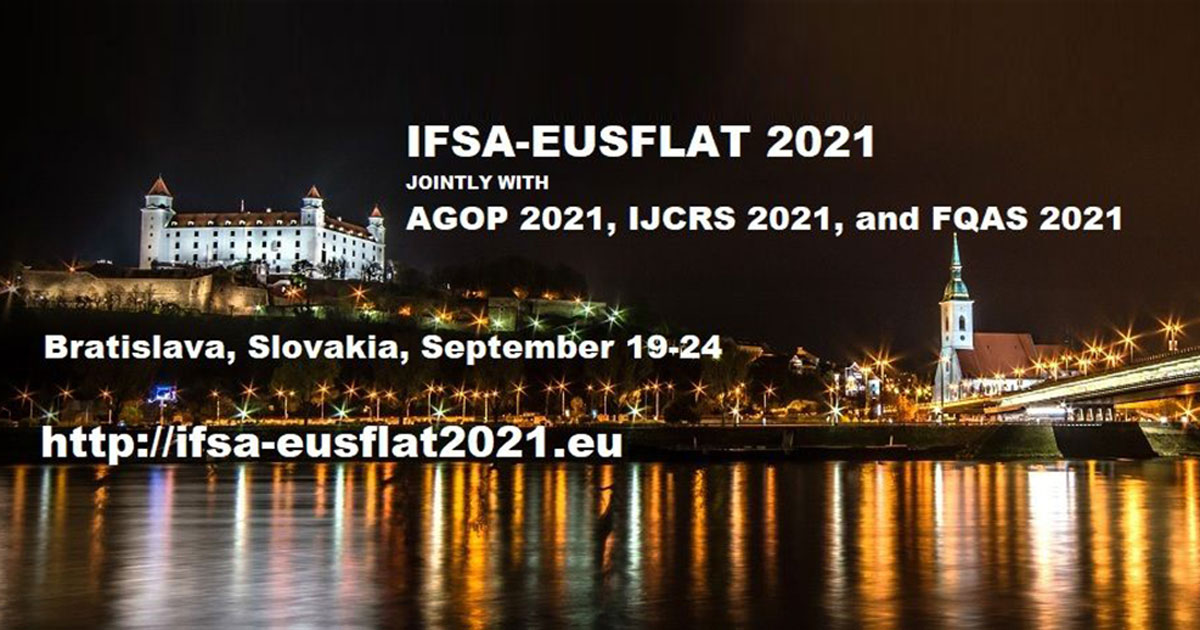- 2.2Impact Factor
- 4.6CiteScore
- 19 daysTime to First Decision
Fuzzy Natural Logic in IFSA-EUSFLAT 2021
This special issue belongs to the section “D2: Operations Research and Fuzzy Decision Making“.
Special Issue Information
Dear Colleagues,
Fuzzy natural logic (FNL) is a class of mathematical theories (theory of evaluative expressions, theory of fuzzy/linguistic IF-THEN rules and approximate reasoning based on them, theory of fuzzy generalized quantifiers and their syllogisms, models of natural human reasoning) with the goal of developing models of human thinking whose most characteristic feature is the use of natural language.
The topics of the Special Issue include, but are not limited to:
- development of various theories belonging to FNL,
- fuzzy quantifiers,
- generalized syllogisms,
- square of opposition and its generalizations,
- systems based on fuzzy/linguistic IF-THEN rules,
- theory (and applications) of approximate reasoning,
- higher-order fuzzy logics,
- partial fuzzy logics,
- linguistic theories of evaluative expressions and quantifiers,
- applications of FNL in data mining, linguistics, decision making, learning, and elsewhere.
We will publish mainly extended versions of the papers presented at the IFSA-EUSFLAT 2021 conference, held in Bratislava. We expect to receive at least 50% of new content for extended conference papers. However, we will also accept submissions of topic-related papers from outside of this conference. Linguistically or philosophically oriented papers are also welcome.
Dr. Antonin Dvorak
Prof. Dr. Vilém Novák
Guest Editors
Manuscript Submission Information
Manuscripts should be submitted online at www.mdpi.com by registering and logging in to this website. Once you are registered, click here to go to the submission form. Manuscripts can be submitted until the deadline. All submissions that pass pre-check are peer-reviewed. Accepted papers will be published continuously in the journal (as soon as accepted) and will be listed together on the special issue website. Research articles, review articles as well as short communications are invited. For planned papers, a title and short abstract (about 250 words) can be sent to the Editorial Office for assessment.
Submitted manuscripts should not have been published previously, nor be under consideration for publication elsewhere (except conference proceedings papers). All manuscripts are thoroughly refereed through a single-blind peer-review process. A guide for authors and other relevant information for submission of manuscripts is available on the Instructions for Authors page. Mathematics is an international peer-reviewed open access semimonthly journal published by MDPI.
Please visit the Instructions for Authors page before submitting a manuscript. The Article Processing Charge (APC) for publication in this open access journal is 2600 CHF (Swiss Francs). Submitted papers should be well formatted and use good English. Authors may use MDPI's English editing service prior to publication or during author revisions.
Keywords
- fuzzy natural logic
- generalized (fuzzy) quantifiers
- fuzzy IF-THEN rules
- approximate reasoning
- mathematical fuzzy logic

Benefits of Publishing in a Special Issue
- Ease of navigation: Grouping papers by topic helps scholars navigate broad scope journals more efficiently.
- Greater discoverability: Special Issues support the reach and impact of scientific research. Articles in Special Issues are more discoverable and cited more frequently.
- Expansion of research network: Special Issues facilitate connections among authors, fostering scientific collaborations.
- External promotion: Articles in Special Issues are often promoted through the journal's social media, increasing their visibility.
- e-Book format: Special Issues with more than 10 articles can be published as dedicated e-books, ensuring wide and rapid dissemination.

